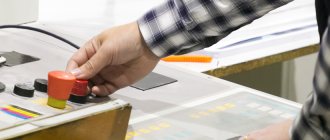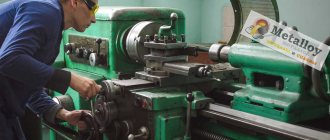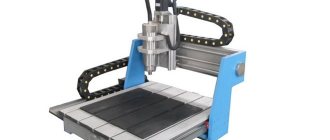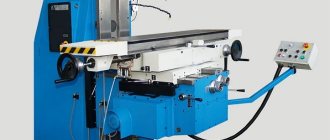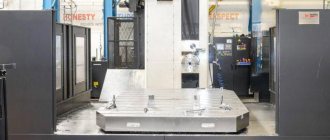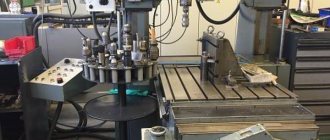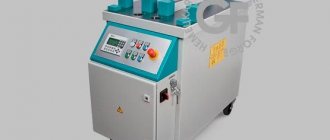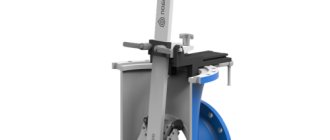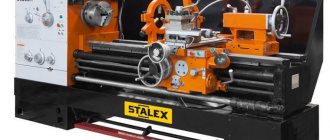The design of a lathe and its operating principle
A CNC lathe for metal of any modification consists of the following parts:
- the base of the machine, the location of all its parts - the bed;
- the main components of the mechanism are located in the spindle (front) headstock - the feed box and the spindle;
- support – with the help of the upper and lower carriages the machine cutter is fixed during operation;
- feed box - a mechanism that provides movement to the caliper with the cutter;
- electrical part – consists of an electric motor and an electrical equipment control unit;
- turret heads – ensure quick change of tools during work.
Turret head of a
CNC lathe machine works on the following principle:
- metal workpieces are clamped in the machine structure in a certain position, horizontally or vertically;
- the cutter, controlled by software, then grinds them into the desired shape.
Technical characteristics overview
Wood processing
All CNC lathes can be divided into two types - with a horizontal or vertical tool holder. Models of the first type are most often used, as they have advanced functionality. To become familiar with it, it is recommended to read the contents of the equipment passport. To do this, you need to know the basic technical parameters of the installation.
First of all, the dimensions and weight of the equipment are taken into account. They directly influence the installation location and determine the requirements for its arrangement. You should also take into account the total power of the electrical part. The total load should not exceed the rated power supply.
Main technical and operational parameters of CNC lathes:
- maximum permissible workpiece diameter. The installation method is taken into account - above the support or above the frame;
- length of the part and its mass;
- the amount of carriage displacement along the coordinate axes. For this indicator, the degree of error is important;
- limits of head spindle speed, rpm;
- spindle hole diameter;
- feed characteristics;
- turret head parameters. Number of installed tools;
- characteristics of threads, their type and formation parameters.
The properties of the cooling system and coolant supply must be considered as additional components. These pieces of equipment are necessary to reduce the degree of heating of the part and cutting tool. Long battery life requires a chip removal system.
In addition to the characteristics of a CNC lathe, the parameters of the workpieces are important - the properties of the manufacturing material, configuration. They are taken into account when drawing up a program for equipment operation.
Design features of the machines
The productivity and reliability of today's lathes are due to their design features. These include:
- preheating of the unit components reduces thermal deformations during processing;
- effective vibration isolation;
- transmission devices in the drives of turning units are devoid of any gaps;
- the length of kinematic chains and the number of mechanical gears are significantly less;
- equipped with feedback alarms.
Such devices are characterized by high precision of movements of all mechanisms due to the presence of wear-resistant guides with low friction force.
The roller guides have high rigidity due to preload, and the slide and bed guides are made from a mixture of fluoroplastic with cast iron or steel. Therefore, increasing operating speeds does not affect the friction indicator.
The main structural elements of the machines are box-shaped and have transverse ribs. Recently, foreign manufacturers have begun to use polymer concrete and synthetic granite for the manufacture of beds, slides and columns of lathes, to ensure maximum rigidity and vibration insulation.
Spindles and spindle assemblies are also modernized compared to conventional machine models. Nodal supports are equipped with wear-resistant bearings, and the spindle design becomes more complex, with automatic locks and indicators for diagnostics and monitoring of the work process.
Design
Regardless of the type of model, its basic elements remain the same:
- Bed. In simple words, this is a strong and reliable table that can withstand large masses and vibrations, but at the same time remains motionless and convenient for use. For heavy weight products, it is recommended to mount the legs on a concrete base.
- Grandma. This is a node that can be called a work area. He is responsible for maintaining and moving manufactured products. There are two of them - front and rear. The first contains the engine (underneath), the gear switch and the spindle - it is responsible for rotation. In the second - only fixing elements.
- A caliper is a moving part responsible for moving the cutter in several planes. There are also strong clamps installed here that allow you to fix the tool.
The auxiliary devices include the control panel itself. Its task is to program CNC lathes; on different models, working with it differs in detail, but the essence remains the same. With its help, tasks are distributed to all moving components of the equipment, that is, to the rotating spindles (speed, direction) and to the support. The built-in computerized device independently selects the sequence of actions, the maximum possible speed of metal processing and controls the process.
Another auxiliary system is coolant. This is the supply of cutting fluid to the working area, as well as the removal of metal shavings generated during work.
With such machines a high degree of automation can be achieved. The operator's actions are actually optional.
Types of CNC lathes
All machines should be divided into 2 types:
- horizontal machines designed to work with small, and sometimes even small parts;
- vertical.
The horizontal type also includes compact machines for home use.
Compact lathe
The type of machine is determined by the position of the guides - it can be inclined, as well as horizontal or vertical.
Based on the CNC functions, machines can have different properties:
- desktop lathes – compact machines for turning very small parts;
- cutting pipes and shafts - the machines are designed for turning very long and complex parts, and they are also capable of turning internal surfaces;
- cutting bushings and shafts - used for turning holes, processing ends and complex rotating bodies, cutting threads;
- machines with increased productivity - they have increased rigidity due to sliding guides, and are capable of turning any parts from any material in a continuous mode;
- multifunctional machines - cope with work of any level of complexity and any details.
Program-controlled machines should also be divided according to their purpose:
- center - turning of the shafts is carried out in centers fixed by the headstock and tailstock;
- cartridge - there is no tailstock here, and the cartridge is located in the front;
- chuck-centered - have the ability to grind the part only in the chuck or be supported by the center of the tailstock.
Modern CNC machines
Marking of CNC turning equipment
The automated control system for turning group machines can be organized according to three main schemes.
Contour
This scheme involves programming the trajectory of movement (including curved) of the working tool and monitoring the correct implementation of this procedure.
Positional
When implementing such a scheme, the coordinates of the points where the working tool should end up after performing a certain technological operation are programmed.
Adaptive
This scheme involves combining the operating principles of the previous two.
Based on the marking of domestic turning equipment equipped with CNC, it is quite easy to determine the category of such a device.
The alphanumeric designation at the end of the marking indicates precisely the system by which numerical control is organized in this machine:
- F1 - machines in which the working tool moves along predetermined coordinates, while they provide a digital indication;
- F2 - models where the tool movement is implemented according to a positional scheme;
- F3 - turning equipment, which implements a contour circuit for controlling the movement of the tool;
- F4 - models of CNC lathes with an adaptive (universal) control system.
Marking of CNC lathes
In the marking of some models of CNC lathes you can find the alphanumeric designation C1-C5, which indicates that such equipment is distinguished by special technological capabilities. In particular, models whose markings contain the designations C1 and C2 have a low feed limit and a small range of their adjustment. But units whose markings contain the symbols C3, C4 and C5T, on the contrary, have an increased feed range and are distinguished by wide possibilities for their adjustment.
Thanks to their advanced capabilities, machine models marked with the symbols C4 and C5 can be used to effectively perform many technological operations, for example, cutting external and internal threads, processing workpieces that have a cylindrical, conical and shaped shape, including stepped ones. It is worth noting that such mills can process both external and internal surfaces, which differ in the complexity of their configuration.
Main characteristics of CNC lathes
Modern modifications of CNC lathes have the following characteristics:
- the drive has a power of up to 40 kW;
- equipping with three-phase motors or DC motors for the ability to change the spindle speed;
- rotation of the main cutter up to 2 thousand rpm;
- the ability to process very small (on compact devices) and fairly large workpieces - from 100 mm to 1 thousand mm;
- wide feed range - some modifications have the ability to change the feed by approximately 1.5 thousand times;
- many settings allow you to set the movement of the cutter along more complex trajectories in comparison with manual control;
- control is carried out along coordinate axes - the more complex the work, the more coordinates are involved in the process (most often control along two coordinates is used, small-sized tanks use only such a system, but there are models where it is necessary to set up to 5 coordinates at the same time);
- the machine often contains up to 12 cutters;
- Many models are equipped with a chip and dust removal function.
Exhaust system for removing dust from the machine
Souvenirs and decorative items.
Work examples:
Wine bottle packaging. User Sergey K. (Gagarin) Machine Modelist4060
Souvenir DOMBAY. User Alexander B. (Krasnodar) Machine Modelist3040
Clock and hanger. User Nikita T. (Perm) Machine Modelist3040
3. Furniture products (chairs, tables, casings, frame and ceiling models, balusters, etc.) . Work examples:
Facade. User Sergey V. (Saratov) Machine Modelist4060
Casher. User tech. (Chaplygin) Machine Modelist 3040
Reading equipment markings
The machine marking consists of numbers and letters. The first digit on the marking of lathes is always 1. The second digit indicates the type of machine. This is followed by designations of the height of the centers, for example, the numbers “2” or “20” mean the height or “30” - respectively, the height of the centers is 300 mm.
And also on the marking of the machine there is a letter indication of the accuracy class:
- A – very high;
- B – high;
- C – especially accurate (precision);
- P – increased;
- N – normal.
Compact machine models most often have accuracy class “B”.
Based on the markings of Russian-made machines, it is easy to understand which control complex they are equipped with. There are three types of numerical control:
- positional control system for final coordinates at the end of the processing process;
- contour system - the executive bodies of the machine move to specified distances along the coordinate axes;
- An adaptive system combines the capabilities of all systems.
It is easy to determine which system is installed on a particular machine by the last letter and number on the model name:
- F1 – coordinates are specified before starting work;
- F2 – the unit is equipped with a CNC positioning system;
- F3 – control is carried out by the contour system;
- F4 – an adaptive numerical control system is installed on the machine.
Feasibility of application
When, in production conditions, is it profitable to purchase program-controlled equipment?
- The part is very expensive (turbine shaft or blades, aircraft parts, medical equipment parts), which means that the very possibility of error must be eliminated.
- Products are produced in serial batches.
- The part has a complex surface. For its mechanical processing it will be necessary to perform many technological operations.
- During the manufacturing process of a part, minor changes in its design are possible. On a CNC machine, changes to the control program can be made immediately from the unit operator console.
- The part has low tolerance quality (the first 6 out of 19). If numerical control is installed on the machines, then the permissible deviations in the dimensions of the manufactured part are determined by the discrete pitch of the drive, which does not exceed 3 microns.
Programming turning equipment
To perform the work effectively and efficiently, you will first need to correctly and accurately use the control program.
Programming turning equipment is an important and responsible process.
Programming a specific operation for processing a workpiece involves a special route, including:
- Divided into stages: roughing, finishing and finishing. To simplify the entire process and increase productivity, the roughing and finishing stages can be combined into one.
- Strict compliance with design and technological documentation minimizes deviations when positioning and fixing the workpiece.
- Complete production of a part with a minimum number of cycles.
- Optimization of the manufacturing process: rotating bodies are sharpened from the most rigid zone to the least rigid zone in order to avoid the creation of stress concentrators.
- The technology for manufacturing parts on computer-controlled machines often consists of several operations. Operations, in turn, can be performed from several passes.
There are certain programming algorithms that guarantee the final quality of the processed part. Such algorithms include:
- number of passes;
- principle of workpiece processing;
- processing tools (cutters, milling cutters and others).
Incisors
There are machines with holders for all processing tools.
If this is not possible, it is necessary to replace processing tools between processing cycles. Modern technologies also make it possible to install several cutters in a holder or use multifaceted cutters to quickly eliminate processing defects by rotating the cutter.
The most common types of processing tools:
- boring, with rigidly fixed cutters;
- taps for cutting threads;
- diamond-shaped, for milling holes and drawing out the geometry of the part.
Machining tools are installed in the holder in an orderly manner, in the order of their use in the cycle. The beginning of the processing cycle is considered to be when the tip of the cutter touches the workpiece.
Items for gaming and educational activities (chess, backgammon, toys, knife handles, etc.).
Work examples:
Robot manipulator claw for a technical creativity club. User Eduard N. (Krasnodar) Machine Modelist3030
Models of settlements on the Moon and Mars. Contractor LLC "ADM "RADISIGN" (Samara), A.P. Rakov, Yu.S. Ratieva. Machine Modelist4060.
Models of the Eiffel Tower and pistol. User Sergey K. (Gagarin) Machine Modelist4060
Toys. User petr c
Bench lathes
Tabletop machines are used for turning small parts.
Bench lathe
Despite their small size, light weight, and much lower operating speed compared to industrial machines, small-sized units are capable of performing many different operations.
In terms of reliability and quality of work performed, they are in no way inferior to full-size models - after all, modern desktop machines also have numerical control. Such machines are most often used in car services, workshops, educational institutions and, of course, in everyday life.
Home units have many advantages:
- low price;
- connection to a 220 V power supply (it is also recommended to use a 380 V network);
- minimal energy consumption compared to large machines - compact units save energy;
- fairly quiet operation;
- due to its small dimensions, it is ideal for small spaces: workshops or services;
- convenience and ease of use - the work does not require serious training and a lot of special knowledge;
- reliability and durability - with proper and careful operation, the tabletop unit will last for many years without requiring repair or replacement;
- When installing additional elements, it is easy to expand the functionality of the machine, for example, by performing drilling and milling work.
Benchtop lathe and milling machine
Lathes are an integral attribute of large industrial enterprises; they allow solving a wide range of problems in processing not only metal, as was the case with the first models of machines, but also plastic, wood, and other materials.
Purpose
The material is processed using tools made of durable and sharp tool steel. This mechanical action makes it possible to cut a steel cylinder (ball, cone), remove the top layer from it, and also make a through or blind hole.
There are six main tasks that are implemented by the turning method:
- surface grinding – chips are removed from the outside of the part;
- boring from the inside - it is possible to enlarge the internal cavity or perform operations to give the desired shape;
- trimming the end part - a cut, the edge of the workpiece is processed;
- applying grooves or threads;
- drilling holes using a drill or tap;
- sawing a cylindrical steel rod, pipe.
These are standard features of a classic style CNC lathe. But there are universal models that also include milling tools. Accordingly, they can also be used for milling work.
Using the equipment you can work with the following parts:
- bushings;
- shafts;
- balls, for example, for bearings.
Numerical control also makes it possible to manufacture products of complex configurations. Usually this is not large-scale production, but individual orders according to pre-prepared drawings.
Design features
The layout of CNC lathes differs little from classical models: except for the presence of additional elements in the form of stepper motors, which ensure precise adjustment of the position of the carriage, and servo drives.
Main components
The main structural components of a CNC machine are:
- base) bed): the supporting structure on which all other elements of the machine are based. At the same time, it reduces vibrations arising from the operation of the electric motor;
- spindle head: used to install the lathe chuck. Receives torque from the power plant. The rotation parameters are changed through the gearbox;
- caliper: provides offset of the cutter relative to the workpiece. Consists of lower and upper carriages. The first ensures the movement of the unit along the guides of the frame, the second is secured with a tool holder;
- feed system: moves the caliper along one or two planes.
You can increase the productivity of the machine by installing a turret head. It has a complex configuration that allows you to install several cutters at the same time.
There is another device that can be installed, if necessary, on a CNC lathe - a faceplate. It is used when processing parts that are asymmetrical about the axis - connecting rods, levers, housings, etc.
If a large-sized workpiece is processed on a machine, it becomes necessary to evenly distribute its weight between the tailstock and headstock. For this purpose, an additional device is used - a cabinet.
Specifications
CNC lathes are available with vertical and horizontal tool holders. The most common models are the second type (for example, a CNC lathe with bar feed). When choosing equipment, first of all, pay attention to its weight and total power: these parameters are decisive when choosing an installation location and assessing the capabilities of the enterprise’s electrical network.
The main technical and operational characteristics are:
Comparative prices for machines and spare parts
| Model | price, rub. VAT included | |||
| JET JTL-1118CNC | RUB 32,032,123 | |||
| Milling machine ORSHA-F32GF3x01 with CNC | RUB 8,570,735 | |||
| PPK-255B | RUB 253,232 | |||
| UNITECH 623 | RUB 2,972,678 | |||
| Saw blade 315mm x 100T x 32mm x 3.4mm/2.2mm (for laminate) | RUB 1,899 | |||
| 2-axis rotary table 225x175x138mm (AKR-1-302) “CNIC” | RUB 12,057 | |||
| VZ-318.P5 | RUB 13,225 | |||
| Insert for screw plug M 48x1.5 PR 5N | 491 rub. | |||
| Threaded ring M 6.0x0.75 NOT 6g | 101 rub. | |||
| Smooth cork d 12.2 N 7 PR-NE, 2-sided | 537 rub. | |||
| Vernier depth gauge 0-1000mm ШГ-1000, division price 0.02, monoblock “CNIC” (62351) | RUB 9,051 | |||
| Vernier calipers 0 - 250 ШЦЦ-I (0.01) electronic with depth gauge (Calibron) | RUB 8,107 | |||
| Indicator SI-300, 200-300 mm with indicator ICH 10-2M class.accuracy 1 (0.01) | RUB 10,278 | |||
| Center | ||||
| Extractor - bolt and stud remover No. 4 (M8-M10) ШХ15 “CNIC” | 68 rub. | |||
- maximum diameter of the workpiece being processed;
- the method of its installation is above the frame or support;
- workpiece weight and length;
- the amount of carriage displacement along the coordinate axes;
- maximum spindle rotation parameters and the diameter of its hole;
- number of tools that can be installed in the turret;
- feed characteristics.
To increase autonomous operation, the machines are equipped with cooling and chip removal systems. Coolant is supplied to the cutting zone by special devices.
Performance properties
The CNC unit ensures operation of the lathe in automatic or semi-automatic modes. In the first case, the processing speed increases, but control over the quality of the operation is reduced. Therefore, for complex processing, the second mode is used.
If semi-automatic mode is activated, the machine performs only one operation. To start the next one, operator intervention is required. This technique is used in single production. After measuring the actual characteristics, it is possible to adjust the program.
In mass production, equipment operates automatically using standard programs. They are subject to change only in the event of a transition to the production of another type of part.

